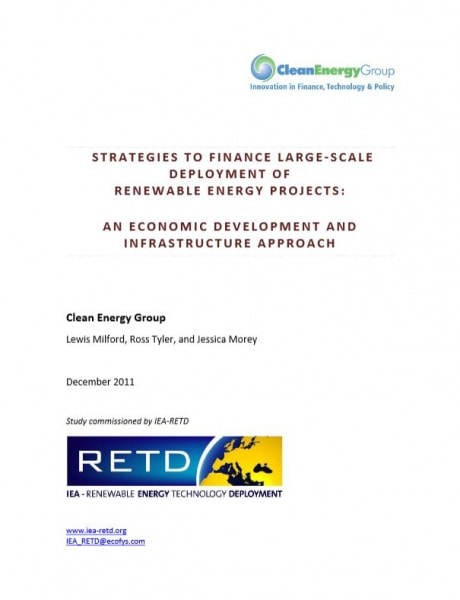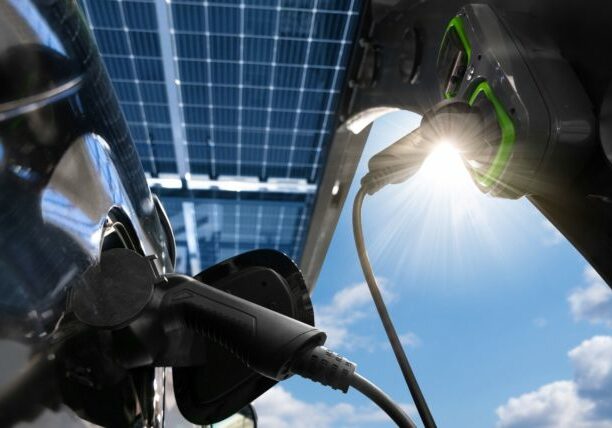December 5, 2011
Clean Energy Scale Up: Do It Like We Did Bridges and Roads
By Lewis Milford

To date, neither the necessary funds nor any convincing mechanisms to produce the funds have come from the public- or the private-sector. Such financial commitments have been made all the more difficult in the current financial crisis, with historic budget deficits in OECD countries.
The fact of the matter is that the level of capital needed is available, but only if new, conventional investors are brought into the clean energy space on terms that are within their investment parameters. New approaches are required in order to access, attract, and direct these new funds to build a clean energy infrastructure.
Clean Energy Group (CEG) has prepared a new report for the International Energy Agency/RETD on this question, which was released today, as global climate discussions are underway in Durban.
The report finds that a fundamental task for public finance and policy is to improve the clean energy investment risk-to-reward ratio needed to entice private investors. The risk-to-reward ratio is a comparison of how much money an investment could lose compared to its profit potential. To encourage private investors to direct capital into clean energy technologies, governments have an important role to reduce the risks associated with clean energy technologies (technical, institutional, policy) and, at the same time, increase the profit potential of these investments.
Investors have different comfort levels that match the wide range of risks and rewards. Venture capitalists take on high risk for the expectation of high returns. On the other hand, institutional investors, such as pension funds, look for lower-risk investments with reliable lower returns—for example, infrastructure bonds.
In order to better align these conventional investor needs with the funds that are required for financing large-scale deployment of renewable energy projects, some questions need to be answered:
- Which policies can influence clean energy infrastructure investments to perform like (or better than) traditional infrastructure, industrial, and municipal bonds?
- What kinds of policies will reduce risk and generate competitive returns for clean energy?
- Are existing investment institutions sufficient or should new institutions help restore investor confidence where it has been eroded by a history of changing or short-term policies?
The solution is unlikely to be action to simply to scale up more of the same public subsidies—an unviable option with many countries facing unprecedented national deficits. Rather, a possible alternative path forward could come from combining existing support mechanisms with new public finance measures that are now used to finance infrastructure like roads, bridges, and other public infrastructure projects.
The major task for governments and the private sector is to conceive of the clean energy challenge as an infrastructure-building exercise for the next thirty to fifty years. This challenge will require many tools that were employed by industrial economies over the last century to build out the existing transportation, telecommunication, and energy infrastructure systems that dominate today.
These infrastructure systems relied on at least four kinds of targeted public and private approaches to achieve their unprecedented dominance.
- Economic development policies to address and link the many actors throughout the economic system, using: “innovation economics” to create incentives, overcome institutional barriers and build the case for a large scale technological transition
- Financial innovation and mechanisms that made it possible for a diverse range of private investors to obtain safe and predictable returns because of public interventions that reduced investor risk and created stable investment environments, and thereby made trillions of dollars in capital available for major infrastructure investments.
- Technology innovation strategies that drove cost reductions and performance improvements in new technologies and crucial enabling technologies that created and supported the integration of new infrastructures into mainstream society.
- Enabling energy policies that mandated investments in infrastructure created a stable investment demand that gave investors confidence to invest based on a predictable, long-term returns horizon.
The paper also recommends that electric utilities must step us to be engines of technology innovation. To date, electric utilities have done little innovation. In the US, state renewable mandates have forced them to acquire power from renewable technologies like wind and solar. But those laws have generally moved the dial for conventional, commercial renewable technologies.
What is needed to address climate is new innovation in second generation technologies, in new markets like offshore wind and for new technologies like energy storage. To do that, we need new laws to mandate utility investments in technology innovation and new ways to reduce technology risk for those investments. CEG has written about these utility recommendations before (see our 2010 report Weathering the Storm: Public funding for low-carbon energy in the post financial crisis era). And a new book by MIT professor Richard Lester (“Unlocking Technology Innovation”) also advocates the need to reform electric utilities as a means to unlock climate innovation.
In short, an economic and infrastructure systems-approach made it possible for societies to scale up major technological transitions throughout history. It is the way built infrastructure becomes culturally dominant.
It is also the way that clean energy and all its institutional frameworks must evolve for them to achieve scale and technological dominance.














